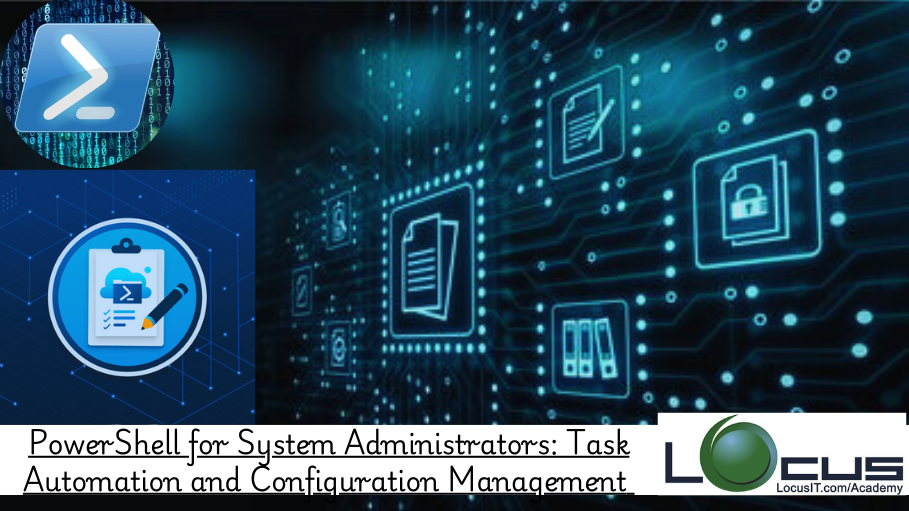Description
Introduction
PowerShell is a powerful scripting language and automation tool for system administrators. This course is designed to help IT professionals automate repetitive administrative tasks, manage system configurations, and streamline their day-to-day operations. With PowerShell, system administrators can manage everything from server configurations to software installations, remote management, and more, all from a single command-line interface. This course covers the foundational skills required to automate common administrative tasks, configure system settings efficiently, and improve operational productivity across various IT infrastructures. By mastering PowerShell, administrators can save time, reduce errors, and ensure consistency in system management.
Prerequisites
- Basic understanding of Windows operating systems
- Familiarity with command-line interfaces
- Some knowledge of system administration concepts is helpful but not required
Table of Contents
- Introduction to PowerShell for System Administration
1.1 PowerShell Overview and Basic Syntax
1.2 PowerShell Cmdlets and Pipelines
1.3 Understanding Objects and Output in PowerShell
1.4 Customizing PowerShell Profiles and Environments - Task Automation with PowerShell
2.1 Automating Common Administrative Tasks
2.2 Scheduling Tasks with PowerShell
2.3 Writing Scripts for Routine System Administration
2.4 Using Loops, Conditionals, and Error Handling - Working with Files and Directories
3.1 Managing Files, Folders, and Permissions
3.2 Automating Backup and Restore Processes
3.3 Searching for Files and Data on the File System
3.4 Using PowerShell to Create and Manage Logs - Managing System Services and Processes
4.1 Starting, Stopping, and Managing Services
4.2 Automating Service Monitoring and Reporting
4.3 Working with Processes and Task Manager
4.4 Handling Long-Running Processes and Job Management - Configuration Management with PowerShell
5.1 Understanding Desired State Configuration (DSC)
5.2 Automating Configuration with DSC(Ref: PowerShell and Active Directory: Automating User and Group Management )
5.3 Managing System Settings and Profiles
5.4 Managing Network Configuration (IP, DNS, and Firewall) - Remote Management with PowerShell
6.1 PowerShell Remoting Setup and Best Practices
6.2 Managing Remote Systems and Servers
6.3 Running Remote Commands and Scripts
6.4 PowerShell Remoting over HTTPS and SSH - Managing Active Directory with PowerShell
7.1 Working with Active Directory Cmdlets
7.2 Automating User and Group Management
7.3 Managing Organizational Units (OUs) and GPOs
7.4 Reporting and Auditing Active Directory Changes - Managing Windows Server with PowerShell
8.1 Installing and Configuring Windows Server Roles and Features
8.2 Automating Server Maintenance and Updates
8.3 Configuring Server Network Settings
8.4 Managing Server Storage and Volumes - PowerShell and Cloud Integration
9.1 Using PowerShell with Microsoft Azure
9.2 Automating Cloud Resource Management with Azure PowerShell
9.3 Managing AWS Resources with PowerShell
9.4 Working with Cloud Storage and Backup Solutions - PowerShell Scripting for Security
10.1 Automating User and Permission Audits
10.2 Managing Security Policies and Access Control
10.3 Configuring Windows Defender and Antivirus
10.4 Automating Patch Management and Updates - Advanced PowerShell Techniques
11.1 Writing Custom Cmdlets and Functions
11.2 Using Modules and Libraries for Extended Functionality
11.3 Debugging and Troubleshooting PowerShell Scripts
11.4 Optimizing PowerShell Scripts for Performance - Real-World Applications and Projects
12.1 Automating Software Deployment Across Multiple Systems
12.2 Building and Deploying Configuration Management Scripts
12.3 Creating System Health and Monitoring Dashboards
12.4 PowerShell for Disaster Recovery and System Backups
Conclusion
By completing this course, you will gain the skills needed to fully automate system administration tasks, enhance your efficiency, and improve configuration management across your organization. PowerShell is an indispensable tool for system administrators, allowing for seamless management of both on-premise and cloud-based infrastructures. You’ll leave this course equipped to write advanced scripts, automate key tasks, manage complex systems, and troubleshoot PowerShell scripts effectively. Whether managing users, servers, or networks, mastering PowerShell will greatly improve your productivity and the consistency of system operations in your organization.







Reviews
There are no reviews yet.